That’s certainly a mouthful. However, it is the proper title of what we usually call The Nicene Creed.
![]() To explain: This primary statement of the Church’s Faith was written at two Ecumenical Councils: the first section at the First Council of Nicaea (AD 325), and the last at the First Council of Constantinople. Furthermore the Greek word “symbolon / σύμβολον” has taken on an entirely different meaning in English (let’s not go into that now). Instead we usually use the word “creed” (from Latin “credo”, “I believe”). Therefore our usual title is simply “The Nicene Creed”. And aren’t you glad?
To explain: This primary statement of the Church’s Faith was written at two Ecumenical Councils: the first section at the First Council of Nicaea (AD 325), and the last at the First Council of Constantinople. Furthermore the Greek word “symbolon / σύμβολον” has taken on an entirely different meaning in English (let’s not go into that now). Instead we usually use the word “creed” (from Latin “credo”, “I believe”). Therefore our usual title is simply “The Nicene Creed”. And aren’t you glad?
Are you still reading? That was a terrible dull beginning, but I thought we might as well get it over with.
A brief Introduction
“Brief”, because what I want to focus on is the content of the Creed. However, first just a little more information:
Traditional Western Christians also have two more Creeds: “The Apostles’ Creed“, and “The Athanasian Creed“.
The Apostles’ Creed is a sort of abbreviated Nicene Creed, once attributed to the Apostles, though it was not written by them. It probably originated in Gaul (France) in the Fifth Century. It’s still in common use.
The Athanasian Creed is a much-enhanced version of the Nicene Creed, rarely if ever used in worship any more. (Look it up, and I think you’ll understand why.) It was attributed to Saint Athanasius, but actually it also first appeared in France in about the Fifth Century.
If you visit certain non-Orthodox churches, you may come across other “creeds”. For example, The United Church of Christ (an American Protestant denomination) has some modern statements of faith, one of which begins “We believe in you, O God, Eternal Spirit, God of our Savior Jesus Christ and our God, and to your deeds we testify” – carefully avoiding the “sexist” words “father” and “son”.
Well, it’s a free country. But the Orthodox reaction to that is: “![]() “. Don’t try to improve on the revelation of God in Jesus Christ, as recorded in the Holy Scriptures and made clear by the Fathers. That’s what the Church’s Creed was designed to protect us from.
“. Don’t try to improve on the revelation of God in Jesus Christ, as recorded in the Holy Scriptures and made clear by the Fathers. That’s what the Church’s Creed was designed to protect us from.
We Orthodox use only the one original Creed of Nicaea/Constantinople, so we usually call it just “The Creed”.
Where did the Nicene Creed come from? The Fathers at Nicaea didn’t start from scratch. In the earliest Church there were various local statements of the Faith, all amounting to the same thing. The first sections of the Creed apparently came from either Palestine or Syria, though some Coptic Orthodox say they were written by Saint Athanasius, that young deacon of Alexandria who was a brilliant opponent of Arius. It certainly sounds like him. Whatever the source, it was chosen by the Fathers as the clearest expression of what the Church has always believed.
The Creed was, of course, written in Greek. There are several English translations. I do wish we Orthodox could get together on just one.
Enough of this. Let’s get to the contents.
The Creed
I believe in one God, Father Almighty, Creator of heaven and earth, and of all things visible and invisible.
Note first that the Creed begins “I believe in…“, not “I believe that there is...” The Creed is not first of all a statement of doctrine. It is a statement of faith, of trust. It’s like the difference between saying “I believe you exist“, and “I believe in you”. n
The form of the Creed authorized by the Ecumenical Councils began “We believe…” This is the Faith of all who comprise The Church.
However – have you ever noticed? – while almost everything else in the Divine Liturgy is in first person plural “we” form, the Creed is first person singular: “I believe…”. Why? Probably because at first the Creed was used to question individual candidates for Holy Baptism, as it still is: “Do you believe…” “I believe…” (The Creed wasn’t added to the Divine Liturgy till some centuries after the Council.) Reciting the Creed at Liturgy is now a sort of renewal of our Baptisms: “I believe in one God…” – which, recited by each of us individually but all of us together, thereby identifies us personally with the Faith of the Church.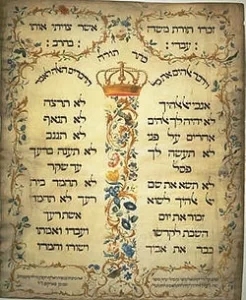
Now, brothers and sisters, listen closely: To say the Creed without believing it is one of the things forbidden by the Fourth Commandment, “Do not take the name of the Lord your God in vain.” That applies to any time we speak of God without meaning it, including when we say the Creed.
Amsterdam Synagogue, 1768
Dare we recite the Creed if we’re not quite sure about parts of it at the moment? I think the answer is Yes – many of us have occasional doubts -but only if we say it with the firm intention of letting God and His Holy Church lead us into belief (“Lord, I believe. Help my unbelief”) I see no problem there. But to just rattle off the Creed, not believing and not desiring to… don’t do that! That’s taking your soul into your own hands.
“One God… Creator…” I read that well over half the world today is monotheistic: Jews, Muslims, Christians, over 3.3 billion people. It seems self-evident to most in our culture that one rational personal power lies behind all things. After all, if we just think about it, creation requires a Creator, design requires a Designer, and the cosmos (except for us human beings) seems to function in a consistent way, 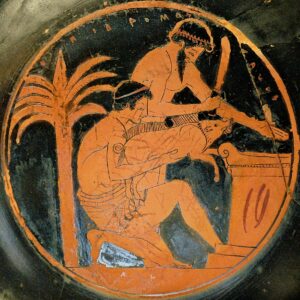 suggesting one Origin. However, when the Creed was written (and as is still the case in much of the Eastern world) that was not obvious. Almost all people still believed in many gods, and they must have gone nearly crazy praying first to this one, then sacrificing to that one, and lighting a candle to another.
suggesting one Origin. However, when the Creed was written (and as is still the case in much of the Eastern world) that was not obvious. Almost all people still believed in many gods, and they must have gone nearly crazy praying first to this one, then sacrificing to that one, and lighting a candle to another.
As Christianity moved out into the pagan world, this was part of the Good News they brought: We can unite our lives serving one God, from Whom we came and to Whom we belong. That part of the Good News came from the Old Testament Jews, who previously had been unwilling or unable to share it. How did the Jews know it? that obscure little tribe at the east end of the Mediterranean. They said God had revealed Himself to them. They surely didn’t philosophize their way into it, because they then had few if any philosophers.
“One God, Creator” – not “who once created”. God creates all things continually. If He stopped creating for an instant, right now, I would never finish this sentence. But He continues. Thank God.

He is “Creator of “heaven and earth“- both our planet and the “spiritual” world above (beyond/around) us “where His will is done”, from which He and the saints reach out to us now, into which we may enter after we die (and even in a limited way, even now) if we so choose.
He is Creator “of all things, visible and invisible“. Have you looked at what space telescopes are discovering in the cosmos? all those trillions upon trillions of galaxies, stars, planets. He is Creator or all that – and probably also of other cosmoses which are beyond our seeing. (What is going on in that “dark matter”?)
Above is a small patch of sky within only our own galaxy – the “Milky Way”.
This one God from His “command-post” rules and controls it all – from the particles (or whatever they are) moving within the unimaginable numbers of atoms in the universe, to the farthest of the trillions of galaxies. He has been God from “before” He first called our cosmos into being, and He will still be God “after” our cosmos is gone. He is eternal.
Brothers and sisters, once in a while take a few minutes to just begin to try to take all that in. But then stop, before it sends your mind into “overload”. It’s too much for us limited mortals cope with.
Therefore, it follows that all power and authority comes from Him – from Vladimir Putin to the King of England to bishops and priests and fathers and mothers – and all accountable to Him.
That is, assuming God is paying any attention. I think our natural assumption would be: He is not. How could God possibly even notice us – we infinitesimal specks of existence on one infinitesimal planet?
The amazing answer is: Not only does He notice us: “Are not five sparrows sold for two copper coins? And not one of them is forgotten before God. Even the very hairs of your head are all numbered.” Luke 12:6-7 He is also our Father who loves us! who cares about us, wants to share His eternal glory with us. Why ever would we believe such a thing? Because Jesus said so. He was the first to teach us to pray, “Our Father…” And why should we believe what Jesus told us? Because the Christian claim from the beginning has been that in that One Man, Jesus of Nazareth, the One God has taken flesh and dwelt among us.
That is a startling astounding claim – which brings us to the next section of the Creed.
But first a current issue: May we pray to the Creator God as “Our Mother”? After all, both male and female are created in His image, so motherhood also is rooted in Him. In their love and care mothers are certainly like God, reflecting the love and care of God – sometimes, I’m sorry to say, a lot better than some of us men. However, the answer is No. Christ always referred to God as “He” and “Father”, never as “she” or “mother”. Jesus Christ is our Lord. We try to follow Him.
________________________________________
And in one Lord Jesus Christ, the only-begotten Son of God, begotten of the Father before all ages; Light of Light, true God of true God, begotten, not created, of one essence with the Father, through Whom all things were made.
That seems, at first, a rather over-extensive definition of Jesus Christ. There was a reason for it. There still is.
In the earlist centuries AD, the Church hadn’t yet developed language to express the undefinable Mystery of Jesus Christ. After all, His Incarnation was utterly unique. There were no words for what we now take for granted – that Jesus Christ is true God and true Man united in One Person, that He is One of the three Persons of God.
From the beginning Jesus’ Divinity and Humanity were accepted in almost all Christian circles. (Some Gnostics actually disbelieved He was human, but that idea was quickly rejected by Christians as a whole.) Traditionally the Church has defined doctrines only when forced to, for fear of diminishing the inexpressible Mystery. However, in the Fourth Century they were forced to.
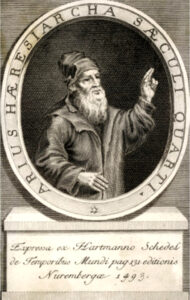 A major controversy arose as to whether Christ was truly divine. Arius, a priest of Alexandria, began to teach that “there was a time when Christ was not”. Arius was not a deep thinker. Apparently he thought that when Jesus called Himself “Son of God”, that meant He was younger than God the Father. Problem: God is eternal. If Christ is God, then He is eternal. He can’t be younger than anyone.
A major controversy arose as to whether Christ was truly divine. Arius, a priest of Alexandria, began to teach that “there was a time when Christ was not”. Arius was not a deep thinker. Apparently he thought that when Jesus called Himself “Son of God”, that meant He was younger than God the Father. Problem: God is eternal. If Christ is God, then He is eternal. He can’t be younger than anyone.
An imaginative portrait of Arius
The New Testament is clear about who Jesus is. Three examples:
“Thomas said to Him, ‘My Lord and my God.'” John 20:28
“…who, although He existed in the form of God, did not regard equality with God a thing to be grasped.” Philippians 2:6
“And He said to me… I am the Alpha and the Omega, the First and the Last, the Beginning and the End.” Revelation 22:13
To call Christ “Son of God” actually means He is the same “nature/essence” as His Father, just as a human son is human like his father.
Nevertheless, for reasons hard to explain, Arianism spread rapidly, and Christians were becoming seriously confused and divided. So in AD 325 the Emperor 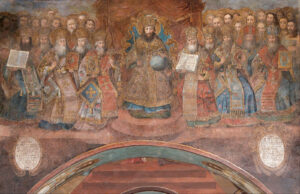 Constantine called the Bishops to Nicaea to settle the matter. There was great contention among them as they tried to find the best words to express Christ’s divinity, but there was no disagreement about whetherIs He is God. Evidence: The final vote appears to have been 318-2 in favor of the forepart of the Creed, the clear affirmation of the Divinity of Jesus Christ, which we recite today at every Divine Liturgy.
Constantine called the Bishops to Nicaea to settle the matter. There was great contention among them as they tried to find the best words to express Christ’s divinity, but there was no disagreement about whetherIs He is God. Evidence: The final vote appears to have been 318-2 in favor of the forepart of the Creed, the clear affirmation of the Divinity of Jesus Christ, which we recite today at every Divine Liturgy.
Perhaps you’ve heard the story that at the Council Saint Nicholas of Myra got so angry at Arius that he went up and slapped him in the face! and got himself thrown out because of that.
Well, the words of the Creed were a verbal, theological “slap in the face” to Arius. Most of the 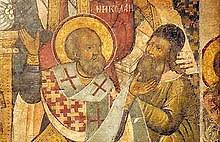 Creed is a summation of Scriptural teaching, but here they quoted the exact words of Scripture against Arius – and that is why this section of the Creed is so long. They wanted no misunderstanding.
Creed is a summation of Scriptural teaching, but here they quoted the exact words of Scripture against Arius – and that is why this section of the Creed is so long. They wanted no misunderstanding.
Was there a time when Christ was not? Was Christ created? Was He one of many sons of God? Is He truly the Light of God? Is He of one essence with the Father? Listen:
“He was in the beginning with God. All things were made through Him, and without Him nothing was made that was made.” John 1:3-4
“In Him was life, and the life was the light of men.” John 1:9
“For God so loved the world that He gave His only begotten Son…” John 3:16
“And now, O Father, glorify Me together with Yourself, with the glory which I had with You before the world was created.” John 17:5
“The Father and I are One.” John 10:30
The Jewish authorities understood Him better than Arius did. They wanted to kill Him “because He was even calling God His own Father, making Himself equal with God.” John 5:30
Arius, you are wrong, wrong, wrong.
The purpose of the Creed (and the purpose of the Fathers in all the Seven Ecumenical Councils) was to defend the revealed Mystery of God in Jesus Christ our Lord from any who would deny, narrow or lessen it.
If you want to read more about the Arian controversy and the First Ecumenical Council, go to:
14. The Story of the Fathers of the First Ecumenical Council: Part 1
15. The Story of the Fathers of the First Ecumenical Council: Part 2
Next Week: The Incarnation of Christ our God “who for us men and for our salvation came down from heaven and was incarnate of the Holy Spirit and the Virgin Mary and became Man.”
Week after Next: The Holy Spirit and The Church
Dear Father Bill. Thank you for the teachings. With Love in Christ / Mats & Diana
Thanks, Mats and Diana. To regular readers: This message was sent by good friends who are currently in Greece. (sigh…)